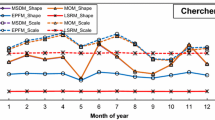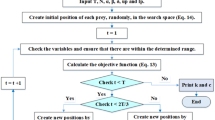Abstract
Accurate estimation of wind speed distributions is a challenging task in wind power planning and operation. The selection of convenient functions for describing wind speed distribution is a crucial requisite. In this paper, remarkable bi-parameter Weibull function is presented to estimate the wind energy potential. Weibull parameters based on different six estimation methods, namely graphical, method of moment, energy pattern factor, mean standard deviation, power density methods, and genetic algorithm are evaluated. Besides, the goodness of fit of the estimation methods is investigated via mean absolute error, root mean square error, normalized mean absolute error, Chi-square error, and regression coefficient. To plainly identify the best matching estimation method, Net Fitness test is also presented. Catalca in the Marmara region in Istanbul, Republic of Turkey, is selected to be the underlying site. The experimental results show the effectiveness of the estimation methods in modeling wind distribution but with relatively small differences in terms of performance. However, the genetic algorithm and energy pattern factor accomplish the best and worst matching estimation methods, respectively.








Similar content being viewed by others
References
Wind Power Capacity Worldwide Reaches 597 GW, 50,1 GW added in 2018 (2019) World Wind Energy Association. Cited July 2020. https://www.indea.org/blog/2019/02/25/wind-power-capacity-worldwide-reaches-600-gw-539-gw-added-in-2018/
Wind energy expanded 19% in 2019, with around 60 GW of new capacity (2020) Reve. Cited July 2020. https://www.evwind.es/2020/07/05/wind-energy-expanded-19-in-2019-with-around-60-gw-of-new-capacity/75563
Wind portfolio in Turkey increased by 687 MW in 2019 (2020) Balkan green energy news. Cited March 2020. https://balkangreenenergynews.com/wind-portfolio-in-turkey-increased-by-687-mw-in-2019/
Ozerdem B, Ozer S, Tosun M (2006) Feasibility study of wind farms: a case study for Izmir, Turkey. J Wind Eng Ind Aerodyn 94(10):725–743
Guseinoviene E, Senulis A, Seker S, Akinci TC (2014) Statistical and continuous wavelet analysis of wind speed data in Mardin-Turkey. In: 2014 ninth international conference on ecological vehicles and renewable energies (EVER). IEEE, pp 1–5
Kumar KSP, Gaddada S (2015) Statistical scrutiny of Weibull parameters for wind energy potential appraisal in the area of northern Ethiopia. Renew Wind Water Sol 2(1):14
Sohoni V, Gupta S, Nema R (2016) A comparative analysis of wind speed probability distributions for wind power assessment of four sites. Turk J Electr Eng Comput Sci 24(6):4724–4735
Azad AK, Rasul MG, Yusaf T (2014) Statistical diagnosis of the best Weibull methods for wind power assessment for agricultural applications. Energies 7(5):3056–3085
Carrillo C, Cidrás J, Díaz-Dorado E, Obando-Montaño AF (2014) An approach to determine the Weibull parameters for wind energy analysis: the case of Galicia (Spain). Energies 7(4):2676–2700
Bokde N, Feijóo A, Villanueva D (2018) Wind turbine power curves based on the Weibull cumulative distribution function. Appl Sci 8(10):1757
Nwobi FN, Ugomma CA (2014) A comparison of methods for the estimation of Weibull distribution parameters. Metodoloski zvezki 11(1):65
Al-Fawzan MA (2000) Methods for estimating the parameters of the Weibull distribution. King Abdulaziz City for Science and Technology, Saudi Arabia
Ahmed SA (2013) Comparative study of four methods for estimating Weibull parameters for Halabja, Iraq. Int J Phys Sci 8(5):186–192
Bandi MM, Apt J (2016) Variability of the wind turbine power curve. Appl Sci 6(9):262
Azad K, Rasul M, Halder P, Sutariya J (2019) Assessment of wind energy prospect by Weibull distribution for prospective wind sites in Australia. Energy Procedia 160:348–355
Jowder FA (2009) Wind power analysis and site matching of wind turbine generators in Kingdom of Bahrain. Appl Energy 86(4):538–545
Saleh H, Aly AAE-A, Abdel-Hady S (2012) Assessment of different methods used to estimate Weibull distribution parameters for wind speed in Zafarana wind farm, Suez Gulf, Egypt. Energy 44(1):710–719
Celik AN (2003) Energy output estimation for small-scale wind power generators using Weibull-representative wind data. J Wind Eng Ind Aerodyn 91(5):693–707
Chellali F, Khellaf A, Belouchrani A, Recioui A (2011) A contribution in the actualization of wind map of Algeria. Renew Sustain Energy Rev 15(2):993–1002
Saeidi D, Mirhosseini M, Sedaghat A, Mostafaeipour A (2011) Feasibility study of wind energy potential in two provinces of Iran: North and South Khorasan. Renew Sustain Energy Rev 15(8):3558–3569
Mostafaeipour A (2010) Feasibility study of harnessing wind energy for turbine installation in province of Vazd in Iran. Renew Sustain Energy Rev 14(1):93–111
Mohandes M, Rehman S, Rahman S (2011) Estimation of wind speed profile using adaptive neuro-fuzzy inference system (anfis). Appl Energy 88(11):4024–4032
Akdağ SA, Dinler A (2009) A new method to estimate Weibull parameters for wind energy applications. Energy Convers Manag 50(7):1761–1766
Seguro J, Lambert T (2000) Modern estimation of the parameters of the Weibull wind speed distribution for wind energy analysis. J Wind Eng Ind Aerodyn 85(1):75–84
Wadi M, Kekezoglu B, Baysal M, Tur MR, Shobole A (2019) Feasibility study of wind energy potential in turkey: Case study of Catalca district in Istanbul. In: 2019 2nd international conference on smart grid and renewable energy (SGRE). IEEE, pp 1–6
Shata AA, Hanitsch R (2006) Evaluation of wind energy potential and electricity generation on the coast of Mediterranean sea in Egypt. Renew Energy 31(8):1183–1202
Bagiorgas H, Assimakopoulos M, Theoharopoulos D, Matthopoulos D, Mihalakakou G (2007) Electricity generation using wind energy conversion systems in the area of western Greece. Energy Convers Manag 48(5):1640–1655
Morgan EC, Lackner M, Vogel RM, Baise LG (2011) Probability distributions for offshore wind speeds. Energy Convers Manag 52(1):15–26
Pishgar-Komleh S, Keyhani A, Sefeedpari P (2015) Wind speed and power density analysis based on Weibull and Rayleigh distributions (a case study: Firouzkooh county of Iran). Renew Sustain Energy Rev 42(2015):313–322
Brano VL, Orioli A, Ciulla G, Culotta S (2011) Quality of wind speed fitting distributions for the urban area of Palermo, Italy. Renew Energy 36(3):1026–1039
Soukissian T (2013) Use of multi-parameter distributions for offshore wind speed modeling: the Johnson SB distribution. Appl Energy 111:982–1000
Wu J, Wang J, Chi D (2013) Wind energy potential assessment for the site of inner Mongolia in China. Renew Sustain Energy Rev 21:215–228
Carta JA, Ramirez P, Velazquez S (2009) A review of wind speed probability distributions used in wind energy analysis: case studies in the Canary Islands. Renew Sustain Energy Rev 13(5):933–955
Calif R, Schmitt FG (2012) Modeling of atmospheric wind speed sequence using a lognormal continuous stochastic equation. J Wind Eng Ind Aerodyn 109:1–8
Wang J, Hu J, Ma K (2016) Wind speed probability distribution estimation and wind energy assessment. Renew Sustain Energy Rev 60:881–899
Justus C, Hargraves W, Mikhail A, Graber D (1978) Methods for estimating wind speed frequency distributions. J Appl Meteorol 17(3):350–353
Kumar MBH, Balasubramaniyan S, Padmanaban S, Holm-Nielsen JB (2019) Wind energy potential assessment by Weibull parameter estimation using multiverse optimization method: a case study of Tirumala region in India. Energies 12(11):2158
Mathew S (2006) Wind energy: fundamentals, resource analysis and economics. Springer, Berlin
Saxena BK, Rao KVS (2015) Comparison of Weibull parameters computation methods and analytical estimation of wind turbine capacity factor using polynomial power curve model: case study of a wind farm. Renew Wind Water Sol 2(1):3
Akdağ SA, Güler Ö (2015) A novel energy pattern factor method for wind speed distribution parameter estimation. Energy Convers Manag 106:1124–1133
Laban ON, Maghanga CM, Joash K (2019) Determination of the surface roughness parameter and wind shear exponent of Kisii region from the on-site measurement of wind profiles. J Energy 2019 :1–12
Raichle BW, Carson WR (2009) Wind resource assessment of the southern Appalachian ridges in the southeastern United States. Renew Sustain Energy Rev 13(5):1104–1110
Elmasry W, Akbulut A, Zaim AH (2018) Deep learning approaches for predictive masquerade detection. Secur Commun Netw 2018:1–24
Elmasry W, Akbulut A, Zaim AH (2019) Empirical study on multiclass classification-based network intrusion detection. Comput Intell 35(4):919–954
Elmasry W, Akbulut A, Zaim AH (2020) Evolving deep learning architectures for network intrusion detection using a double PSO metaheuristic. Comput Netw 168:107042
Elmasry W, Akbulut A, Zaim AH (2020) Comparative evaluation of different classification techniques for masquerade attack detection. Int J Inf Comput Secur 13(2):187–209
Holland JH et al (1992) Adaptation in natural and artificial systems: an introductory analysis with applications to biology, control, and artificial intelligence. MIT Press, Cambridge
Okorie ME, Inambao F, Chiguvare Z (2017) Evaluation of wind shear coefficients, surface roughness and energy yields over inland locations in Namibia. Procedia Manuf 7:630–638
Gualtieri G, Secci S (2011) Wind shear coefficients, roughness length and energy yield over coastal locations in southern Italy. Renew Energy 36(3):1081–1094
Lackner MA, Rogers AL, Manwell JF, McGowan JG (2010) A new method for improved hub height mean wind speed estimates using short-term hub height data. Renew Energy 35(10):2340–2347
Gualtieri G, Secci S (2011) Comparing methods to calculate atmospheric stability-dependent wind speed profiles: a case study on coastal location. Renew Energy 36(8):2189–2204
Ağçay M, Attay F (2007) Türkiye’nin elektrik enerjisi arztalep dengesinin tespiti, üretim projeksiyonuna yönelikrüzgar elektrik santrali tasarımı res’in kurulummaliyetlerinin ve üretim parametrelerinin analizinin matlab&simulink ile yazılan programdayapılması, Master’s thesis, Yıldız TeknikÜniversitesi, Elektronik Mühendisliği Bitirme Tezi
Willmott CJ, Matsuura K (2005) Advantages of the mean absolute error (MAE) over the root mean square error (RMSE) in assessing average model performance. Clim Res 30(1):79–82
Hyndman RJ, Koehler AB (2006) Another look at measures of forecast accuracy. Int J Forecast 22(4):679–688
Teyabeen AA (2015) Statistical analysis of wind speed data. In: IREC 2015 the sixth international renewable energy congress. IEEE, pp 1–6
Gul M, Tai N, Huang W, Nadeem MH, Yu M (2020) Evaluation of wind energy potential using an optimum approach based on maximum distance metric. Sustainability 12(5):1999
Irwanto M, Gomesh N, Mamat M, Yusoff Y (2014) Assessment of wind power generation potential in Perlis, Malaysia. Renew Sustain Energy Rev 38:296–308
Gul M, Tai N, Huang W, Nadeem MH, Yu M (2019) Assessment of wind power potential and economic analysis at Hyderabad in Pakistan: powering to local communities using wind power. Sustainability 11(5):1391
Rocha PAC, de Sousa RC, de Andrade CF, da Silva MEV (2012) Comparison of seven numerical methods for determining Weibull parameters for wind energy generation in the northeast region of Brazil. Appl Energy 89(1):395–400
Azad AK, Rasul M, Alam M, Uddin SA, Mondal SK (2014) Analysis of wind energy conversion system using Weibull distribution. Procedia Eng 90:725–732
Kang D, Ko K, Huh J (2018) Comparative study of different methods for estimating Weibull parameters: a case study on Jeju Island, South Korea. Energies 11(2):356
Gupta RD, Kundu D (2009) Introduction of shape/skewness parameter (s) in a probability distribution. J Probab Stat Sci 7(2):153–171
Mert I, Karakuş C (2015) A statistical analysis of wind speed data using burr, generalized gamma, and Weibull distributions in Antakya, Turkey. Turk J Electr Eng Comput Sci 23(6):1571–1586
Monahan AH (2006) The probability distribution of sea surface wind speeds. part i: Theory and seawinds observations. J Clim 19(4):497–520
Chaurasiya PK, Ahmed S, Warudkar V (2018) Study of different parameters estimation methods of Weibull distribution to determine wind power density using ground based Doppler SODAR instrument. Alex Eng J 57(4):2299–2311
Acknowledgements
The authors would like to thank the Turkish general directorate of meteorology in Istanbul for their gentleness in providing the raw data for this study.
Funding
This research did not receive any specific grant from funding agencies in the public, commercial, or not-for-profit sectors.
Author information
Authors and Affiliations
Contributions
All authors are involved in developing the concept to make the article error-free technical outcome for the set investigation work.
Corresponding authors
Ethics declarations
Conflict of interest
The authors declare that there are no conflicts of interest regarding the publication of this paper.
Additional information
Publisher's Note
Springer Nature remains neutral with regard to jurisdictional claims in published maps and institutional affiliations.
Rights and permissions
About this article
Cite this article
Wadi, M., Elmasry, W. Statistical analysis of wind energy potential using different estimation methods for Weibull parameters: a case study. Electr Eng 103, 2573–2594 (2021). https://doi.org/10.1007/s00202-021-01254-0
Received:
Accepted:
Published:
Issue Date:
DOI: https://doi.org/10.1007/s00202-021-01254-0




